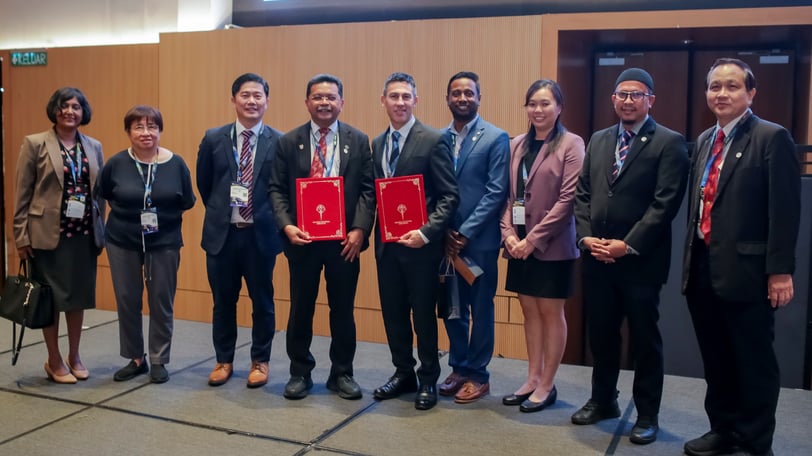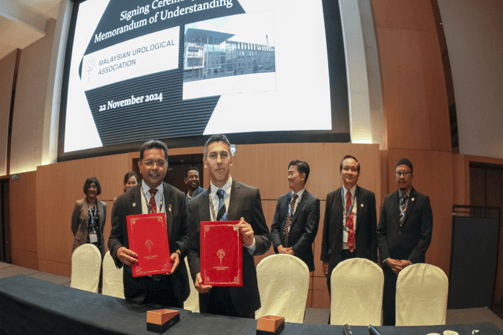Pediatric Urology in Malaysia
Perspectives from a Urologist
By Dr Poongkodi Nagappan
20th March 2025


Figure 1: Mr R Maximillian Cervellione (Director, Department of Paediatric Urology, Royal Manchester Children’s Hospital) and Mr Noor Ashani Md Yusoff (President, Malaysian Urological Association) flanked by members of the Special Interest Group in Pediatric Urology, Malaysian Urological Association at the 33rd Malaysian Urological Conference in Penang
Pediatric Urology is a sub-specialty field, dealing with congenital and acquired diseases of the urinary tract and genital tract of children [1].
A pediatric urologist would be able to make a diagnosis, advise, and provide medical and surgical treatment for the wide range of conditions of involving the genito-urinary system of children and adolescents.
Pediatric Urology in Malaysia
The first multidisciplinary Paediatric Urology, Paediatric Nephrology, and Paediatric Neurology clinic was set up at the Institute of Urology and Nephrology in 1991. This clinic was initiated by Mr Clarence Lei Chang Moh, Dr Lim Yam Ngo, and Dr Ong Lau Choo. The combined pediatric urology and pediatric nephrology serviceservice was further established by Dr Susan Woo Yoke and Dr Yap Yok Chin.
Pediatric Urology is an under-served field in Malaysia requiring long years of surgical training. In the present circumstances, Pediatric Urologists are Urologists who have undergone a four-year postgraduate training in General Surgery, followed by another four years of formal training in Urology, and subsequent one-to-two-year fellowship in a high-volume Pediatric Urology department abroad. These surgeons return to Malaysia to set up and provide Pediatric Urology services whilst balancing their responsibilities in day-to-day adult urology services, which usually includes Adolescent and Transition Urology, Reconstructive Urology, and Functional Urology.
There are numerous reasons for establishing a systematic and organized pathway to train and increase the number of Pediatric Urologists in Malaysia. First, the prevalence of diabetes mellitus [2] and obesity [3] in Malaysia is increasing, and there is a positive association between both conditions during pregnancy [4,5] and having an offspring with Congenital Abnormalities of the Kidney and Urinary Tract (CAKUT). CAKUT is a primary cause of end-stage kidney disease among children [6]. Symptoms of kidney disease in children are non-specific, and chronic kidney disease often progresses silently until there is significant and irreversible loss of kidney function.
A challenge intrinsic to Pediatric Urology is the need to identify children at risk of serious sequelae who require interventions to relieve urinary tract obstruction, urinary incontinence, and prevent chronic kidney disease [7]. At the same time, one must also ensure that the larger group of children with short-lived conditions who present to the health care professional in a similar manner are not subject to unnecessary investigations.
There are many children with urological conditions in this part of the world who need treatment but do not get it. Some of the reasons for the treatment gap are
Younger children with a serious urological condition often present with non-specific symptoms such as fever and vomiting
There is a lack of awareness regarding urological conditions among parents and primary care provider even though the full range of treatment is available in Malaysia
Treatment may not be accessible for patients living in the outskirts and rural areas who may find it a hassle to travel to larger city hospitals
Parents do not feel the need to seek treatment especially for conditions such urinary incontinence in children
Parents may fear the side effects of treatment
There is also a shortage of trained Pediatric Urologists in this region, in comparison to proliferation of teaching programs and saturation of specialists in high-income countries [8].
There have been changes in Urology training in Malaysia. The Parallel Pathway specialist training program allows direct entry of Medical Officers into four-year postgraduate training in Urology. This increases the number of qualified Urologists in the country within a shorter training period.
Having a clear Pediatric Urology fellowship pathway would ensure that young urologists who choose to take up Pediatric Urology are well-equipped with the required ethics, knowledge, and skills to shoulder the responsibility of caring for children with urological conditions in Malaysia. It is to this end that a Memorandum of Understanding was signed in November 2023, between the Malaysian Urological Association and the Department of Pediatric Urology, Royal Royal Manchester Children’s Hospital for collaboration in training and research .


REFERENCES AND FURTHER READING
David A Bloom. The origin of a species: pediatric urology. J Urol 2003;170:1488-92
Akhtar S, Nasir JA, Ali A, Asghar M, Majeed R, Sarwar A. Prevalence of type-2 diabetes and prediabetes in Malaysia: a systematic review and meta-analysis. PLoS ONE 2022;17(1):e0263139
Chong CT, Lai WK, Mohd Sallehuddin S, Ganapathy SS. Prevalence of overweight and its associated factors among Malaysian adults: findings from a nationally representative survey. PLoS One 2023;18(8):e0283270
Parimi M, Nitsch D. A systematic review and meta-analysis of diabetes during pregnancy and congenital genitourinary abnormalities. Kidney Int Rep 2020;5(5):678-93
Jadresic L, Au H, Woodhouse C, Nitsch D. Pre-pregnancy obesity and risk of congenital abnormalities of the kidney and urinary tract (CAKUT) - systematic review, meta-analysis, and ecological study. Pediatr Nephrol 2021;36:119-32
Ingelfinger JR, Kalantar-Zadeh K, Schaefer F. World Kidney Day Steering Committee. Averting the legacy of kidney disease - focus on childhood. Kidney Int. 2016;89(3):512-8.
Strategic plan for Pediatric Urology, NIDDK Research Progress Report 2006. Department of Health and Human Services. National Institutes of Health (NIH) Publication No. 06-5879
Catherine R. deVries. A global view of pediatric urology. J Ped Urol 2022;18(3):271-9
Mr R Maximillian Cervellione (Director, Department of Paediatric Urology, Royal Manchester Children’s Hospital) and Mr Noor Ashani Md Yusoff (President, Malaysian Urological Association) flanked by members of the Special Interest Group in Pediatric Urology, Malaysian Urological Association
Pediatric urologists in Malaysia and this part of the world, have a larger responsibility in addition to diagnosis and treatment of urological conditions. Our commitment should be to prevent chronic kidney disease (CKD) in children and adolescents with normal baseline renal function, especially when one considers the cost of renal replacement therapy among young patients as outlined below. Our other roles include helping young patients with bladder disabilities live with good quality of life, to improve the appearance of the external genitalia, and to preserve fertility potential in young boys and men. As surgeons, we can only find real meaning in the service of people, doing something no one else can or will do.
Life expectancy for patients < 40 years with ESKD in Malaysia is 16 years for patients on haemodialysis and 18 years for patients on peritoneal dialysis [Ref: Lim TO, Lim YN, Wong HS, Ahmad G, Singam TS, Morad Z, et al. Outcome assessment of the Ministry of Health Malaysia dialysis programme. Med J Malaysia 1999;54(4):459-470]
Arterio-venous fistula and haemodialysis - estimated cost per life year is RM 39,791 [Ref: Surendra NK, Abdul Manaf MR, Hooi LS, Bavanandan S, Mohamad Nor FS, Firdaus Khan SS, et al. Cost utility analysis of end stage renal disease treatment in Ministry of Health dialysis centres, Malaysia: Hemodialysis versus continuous ambulatory peritoneal dialysis. PLoS ONE 2019;14(10): e0218422]
Tenckhoff catheter and peritoneal dialysis - estimated cost per life year is RM 37,576 [Ref: Surendra NK, Abdul Manaf MR, Hooi LS, Bavanandan S, Mohamad Nor FS, Firdaus Khan SS, et al. Cost utility analysis of end stage renal disease treatment in Ministry of Health dialysis centres, Malaysia: Hemodialysis versus continuous ambulatory peritoneal dialysis. PLoS ONE 2019;14(10):e0218422]
Estimated total lifetime discounted costs of adult transplants is RM 409,921 (living-related donor kidney transplant) and RM 503,922 (deceased donor kidney transplantation) [Ref: Bavanandan S, Yap YC, Ahmad G, Wong HS, Azmi S, Goh A. The cost and utility of renal transplantation in Malaysia. Transplant Direct 2015;1(10):e45]
Cost of surgical interventions to relieve urinary tract reflux and obstruction - one off cost of RM 12,000-RM 18,000 [estimate from out-of-pocket payment in private hospitals]
Dr Poongkodi Nagappan
20th March 2025
"Much of the clinical challenge intrinsic to pediatric urology rests in the need to discriminate between children at risk for severe long-term complications and requiring intervention and the larger group who are not.”
Strategic Plan for Pediatric Urology. NIDDK Research Progress Report
Department of Health and Human Services. 2006.
National Institutes of Health (NIH) Publication No. 06-5879
